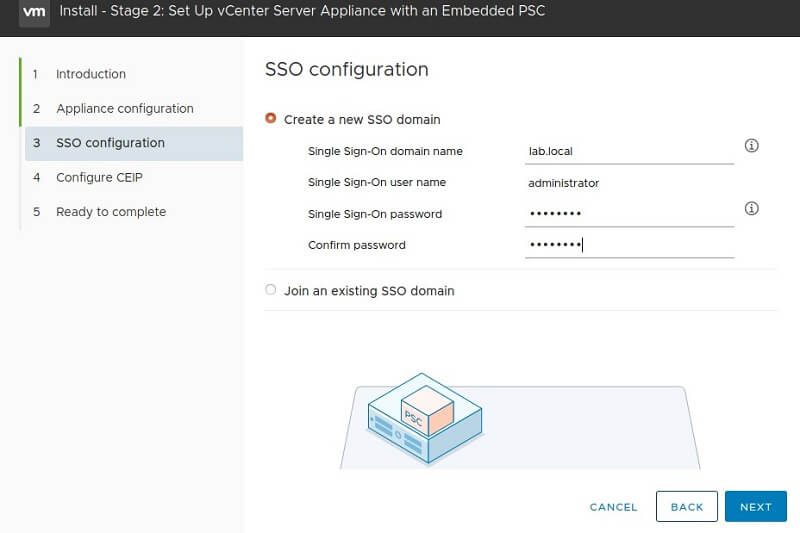

- Vmware vcenter install how to#
- Vmware vcenter install install#
- Vmware vcenter install software#
- Vmware vcenter install password#
In the vCenter client create a new VM with the following specification:
Vmware vcenter install install#
Copy the ISO to a datastore that can be accessed when used to install Windows 11. Create or download a Windows 11 ISO (for more information see the blog post mentioned at the beginning). The Key Provider is configured and active nowįor the Windows 11 VM configuration, I configured the following:. Vmware vcenter install password#
Select Backup and uncheck “ Protect Native Key Provider data with password (Recommended)” and click on BACK UP KEY PROVIDER. Enter a name for the Key Provider and uncheck “Use key provider only with TPM protected ESXi hosts (Recommended). When using the Native Key provider you don’t need an external key server. Click on the vCenter name – Configure and select Key Providers. To enable vTPM you must first add a Key Provider The Key Provider is used to enable encrypted technologies such as TPM Here are the steps: Requirements for vTPM Vmware vcenter install how to#
In this blog post, I explain how to configure vTPM for VMware vSphere and install Windows 11.
Vmware vcenter install software#
A vTPM performs the same functions as a hardware TPM, it performs cryptographic coprocessor capabilities in software So without having a physical TPM 2.0 you can run Windows 11 without performing any hacks to the Windows 11 Operating System. This is called Virtual Trusted Platform Module (vTPM). With VMware vSphere and VMware Workstation, it is possible to install Windows 11 by using a vTPM device that emulates a physical TPM 2.0 chipset without having one. You can just add a virtual TPM in Workstation or vSphere, too. Bob Plankers ( replied on Twitter that virtual TPM can be used too. Paul Braren from created a cool video ( link) about installing Windows 11 on VMware vSphere using my blog article. In this blog article, I explained how to install Windows 11 without having a TPM 2.0 chipset by using a registry hack. We will go over configuring Active Directory Authentication in a later post.Yesterday I wrote a blog called “ Install Windows 11 as VM on VMware vSphere / Workstation without TPM 2.0 chipset“. Viola! Your vCenter appliance up and running. Once the appliance has been deployed, login via the Web Client or C# Client. Upon completion, you can monitor progress of the vCenter deployment. If everything looks appropriate, click Finish You can also Enable SSH if you would like. We will use the embedded Postgres db.Ĭonfigure your network settings. The vCSA supports using an embedded Postgres db or an external Oracle db.

Select the type of database for your deployment. Select the datastore where the appliance will reside.

Check out this great article on virtuallyGhetto. If you choose the wrong size, you can resize the appliance after it has been deployed.
Large (up to 1,000 hosts/10,000 VMs): 16 vCPU, 32 GB memory, 450 GB disk space. Medium (up to 400 hosts/4,000 VMs): 8 vCPU, 24 GB memory, 300 GB disk space. Small (up to 100 hosts/1,000 VMs): 4 vCPU, 16 GB memory, 150 GB disk space. Tiny (up to 10 hosts/100 VMs): 2 vCPU, 8 GB memory, 120 GB disk space. Select appliance size from the drop-down list. Don’t worry you can add AD Authentication later once the appliance is deployed. Issue: Do not use the same Active Directory domain as your SSO domain. Enter the administrator password and SSO Domain name. For more information on deployment topologies check out these links:įor this instance, we will be creating a new SSO domain. This option has the PSC embedded into the vCenter appliance. Since this is in my development environment, we will choose the Embedded Platform Services Controller. Select the Deployment Type for your environment. Run the vcsa-setup.htmlĮnter the pertinent info for the ESXi host where the vCenter Server Appliance will be deployed.Įnter the name and set a root password for the vCenter Server Appliance. Install the VMware-ClientIntegrationPlugin-6.0.0.exe (located in vcsa folder)Īfter the plugin installs, return to the root of the ISO. It now comes as an ISO that you can mount to your local computer. In a change from previous versions, the vCSA is no longer an OVA. To save time make sure your DNS entries are taken care of before the installation (forward and reverse). This is a pretty straightforward deployment. In this byte, we will go over how to install VMware vCenter Appliance (vCSA) 6.0







 0 kommentar(er)
0 kommentar(er)
